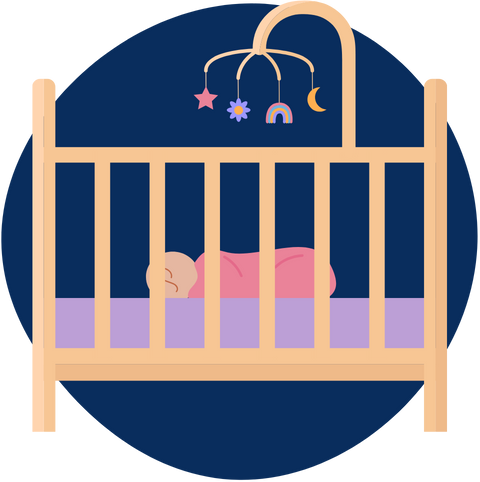It is recommended for newborns (0-3 months) to get 13-17 hours of sleep and infants (4-14 months) to get 12-16 hours of sleep including naps (see the Recommended Sleep Duration table). According to the CDC, there were around 3,700 sleep-related deaths among U.S. babies in 2022. Below, are some ways for parents and caregivers to create and maintain a safe sleeping areas for babies.
Consult your pediatrician if you have any questions regarding your baby's sleeping habits or sleeping environment.

Tips for creating a safe sleep area
-
Place your baby on his or her back for all sleep times (naps and at night).
If a baby spits up while they're asleep, their anatomy and gag reflex help prevent them from choking when placed on their back. Babies who sleep on their back are much less likely to die of Sudden Infant Death Syndrome (SIDS) than babies who sleep on their sides or stomachs.
-
Use a firm, flat (not at an angle or inclined) sleep surface, such as a mattress in a safety-approved crib covered only by a fitted sheet.
Many might feel they should place their baby on a soft surface to help with sleep or to be more comfortable. However, soft surfaces can increase the risk of sleep-related death. A firm surface helps reduce the risk of SIDS and suffocation.
-
Keep your baby's sleep area (for example, a crib or bassinet) in the same room where you sleep, ideally until your baby is at least 6 months old.
Accidental suffocation or strangulation can happen when a baby is sleeping in an adult bed or other unsafe sleep surfaces.
Sharing a room with your baby may decrease the risk of SIDS by as much as 50% and is safer than bed sharing. Placing the crib close to your bed so that the baby is within view can make it easier to monitor your baby. Having them in reach can also help make it easier to feed and comfort them.
-
Keep soft bedding such as blankets, pillows, bumper pads, and soft toys out of your baby's sleep area. Additionally, do not cover your baby's head or allow your baby to get too hot.
Parents and caregivers may feel they should add sheets or blankets to their baby's crib to keep their baby warm and comfortable. However, babies who sleep on soft bedding like sheets, comforters, and blankets may have an increased risk of sleep-related suffocation compared to babies who do not sleep on soft bedding.
If there is concern for a baby being cold during sleep, they can be dressed in sleep clothing. Alternatives to soft bedding include a wearable blanket, also known as a sleep sack, or adjusting the temperature of the room. Products labeled as weighted, including weighted sleepers, swaddles, sleep sacks, and blankets - are not safe for infants.
To learn how to create a safe sleep environment for a baby in your home, view the: Interactive Safe Sleep Environment Tool from Safe to Sleep. (Courtesy: Eunice Kennedy Shriver National Institute of Child Health and Human Development).
Resources
- Safe to Sleep campaign led by the Eunice Kennedy Shriver National Institute of Child Health and Human Development (NICHD)
- Ways to Reduce Baby's Risk (Eunice Kennedy Shriver NICHD)
Reference to specific commercial products, manufacturers, companies, or trademarks does not constitute its endorsement or recommendation by the U.S. Government, Department of Health and Human Services, or Centers for Disease Control and Prevention. This material is otherwise available on the agency website for no charge.